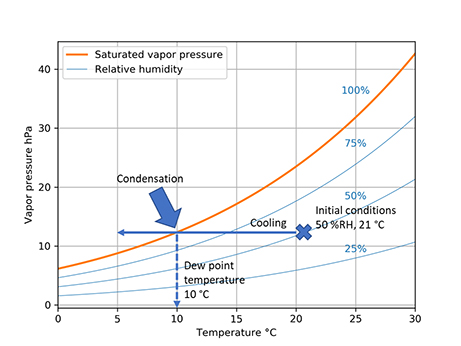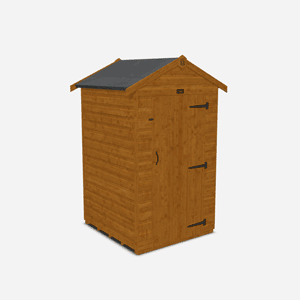How to Damp Proof a Wooden Shed
Published: 11/10/2021

The issue of damp can cause serious problems for the condition and lifespan of your shed – or any garden building for that matter. And it’s with all this in mind that we’ve created this guide on how to damp proof a wooden shed.
We’re here to help you keep your shed stay damp free

We want you to enjoy your garden building for as long as possible – that’s why all our buildings come with a 20-year guarantee. The tight-fitting shiplap boards and high-grade timber on most of our buildings go a long way in helping prevent to damp.
That said, damp can affect even the best sheds, so we aim to answer any related questions you may have in this post. But this post doesn’t just apply to sheds; you may want to know how to stop damp in a summerhouse or log cabin – and we’re here to help.
Perhaps you also want to learn about the best shed waterproofing products, or you’re wondering whether to buy shed vents. Or you may be pondering whether it’s worth purchasing a dehumidifier for your shed. And if you’d like to find out ways to get rid of – or just prevent – mould in your shed, you’re in luck.
So, to find the answers you need, just read this post.
Note: As the title of this post suggests, the information we provide here relates to wooden garden buildings. For information on how to damp proof a brick shed (or metal or plastic ones), the DIY Doctor website is a good source of information [1].
So, let’s start with the question that is no doubt on anyone’s lips when they first discover damp in their shed…
Why is my shed so damp?
The major reasons your shed may become damp include [2]:
- Rising damp
- Condensation
- Penetrating damp
We look into each one of these issues below:
Rising damp

A major – and all too common – cause of rot in garden sheds, rising damp occurs when ground water pools under the shed and is absorbed by the floor bearers and then the floor.
Condensation

In basic terms, condensation occurs when water vapour turns into liquid [3]. In your shed, it can appear when it’s colder outside than it is inside (or vice versa).
Humidity inside the shed cause the air to become damp. While condensation is more common in metal sheds or plastic sheds, the issue can also happen in wooden sheds too – especially when the seams of the building’s doors and windows aren’t properly sealed.
Penetrating damp
Also known as rain penetration, penetrating damp can rear its head when excess water comes through the external wall(s) of a shed. This is what usually causes shed walls to become wet inside.
And this is a good point to explain the differences between waterproofing and damp-proofing a shed…
Damp proofing vs waterproofing
Waterproofing and damp proofing are often confused, which is why customers often ask our experts how to waterproof a damp shed.
But while insufficient waterproofing can cause penetrating damp, waterproofing and damp proofing are not the same. Yes, there is crossover – waterproofing a shed can help keep it from becoming damp, and both procedures help prevent forms of water travel.
Damp proofing prevents soil-moisture build-up
However, damp proofing generally refers to the process of keeping out soil moisture, while waterproofing refers to an ability to prevent the build-up of all forms of water – including water vapour, soil moisture and liquid under hydrostatic pressure (usually from rain).
For this reason, waterproofing tends to be a more extensive procedure. So, if you live in area subject to heavy rain or a high-water table, waterproofing could be the best option. For more information on how to dry out a wet shed, or waterproofing in general, take a look at our guide to creating a waterproof shed.
But if you’re not too worried about heavy rain, or you’ve already taken steps to stop rain getting in, keep reading this post.
Here are 7 ways to damp proof your shed:
1. Make sure the structure is fit for purpose
The need to start with a good base is something we talk about a lot on our blog – and that’s because it’s a must!
If your shed is suffering from cracks in the roof or floor, or the seals on the doors and windows are letting air in – either due to age or damage – then you need to fix these issues.
And if these are beyond repair, it would be wise to buy a new shed. But if your existing garden building is fit for purpose, you’ll already be fighting a winning battle against damp and mould.
2. Check your roof
We realise we mentioned the roof in the first tip, but that’s because the roof is common source of damp in afflicted sheds. Specifically, a damp roof can mean there are cracks in the roof boards, or that the roofing felt or shingles need to be replaced.
Issues with roofing felt and/or shingles
While the best roofing felt is an inexpensive – and effective – way to protect your roof from rain, it does wear with age. If you find any issues with the felt, consider patching it or replacing all of the existing material. Likewise, if your shingled shed roof is looking a little worse for wear, you may need to replace the shingles.
To learn how to replace/repair shingles or roofing felt, read our comprehensive guide to shed roof repair.
3. Treat the building
Unless you have a pressure treated shed or summerhouse, it’s important to treat your garden building at least once a year – starting from when first put it up. This will help to stop rot and ensure damp and mould don’t develop in your shed.
This, in turn, can make sure you’re able to enjoy your garden building for at least the next couple of decades.
What treatment should you use?
We recommend Tiger Sheds Preserver – this solvent-based shed preserver is designed to penetrate deep into the grain of a wooden shed, which protects it against the elements and prolongs the life of your building.
For more expert advice on this subject, check out our post on shed treatment.
4. Insulate your shed
While insulating a shed will certainly help it stay from damp, you may not need to do it – especially if the building is made from tight-fitting tongue and groove boards or logs like most of the buildings in the Tiger range.
That said, insulation can help balance the temperature in your shed, which can help it stay above dew point (see below).
Dew point and insulation

Dew point is defined by the Oxford English Dictionary as:
noun
the atmospheric temperature (varying according to pressure and humidity) below which water droplets begin to condense and dew can form [4].
This is also the point at which condensation starts to form. Insulating your shed stops heat from leaving the building and helps the inside of the shed stay at the same (or similar) temperature to the outside, which in turn helps avoid the build-up of condensation.
For all the information on the different types shed insulation (and how to do it), read our article on how to insulate your shed.
Does a shed base need a damp-proof membrane?
Installing a damp-proof membrane in (or under) the shed base is one way of insulating the building from the threat of damp. This is because a shed membrane can help prevent the build-up of water underneath the shed, thereby protecting it against rising damp.
5. Improve airflow

Ventilating a shed is a must for any damp-proofing process. Why? Because it replaces the air and keeps it moving. This, in turn, prevents humid air touching cold surfaces and stops condensation in its tracks.
A simple way to ventilate the shed is to open the windows and doors regularly. You can also install shed vents to ensure that stale air is constantly replaced by fresher air to prevent damp, mould (and unpleasant smells) appearing.
6. Heat and dehumidify the shed
Installing a shed heater and a dehumidifier can work with ventilation to help damp proof your garden building – and keep it above dew point.
Heating
If your shed is equipped with power, you can install an electrical unit. But if you don’t want – or don’t have the means – to run mains power to your shed or install solar panels, you can use a wood burner.
Dehumidifying
To help keep the atmosphere inside dry, consider buying a dehumidifier for your shed.
If you have an electrical supply, a desiccant dehumidifier is a good option – this type is suitable for both cold and warm climates, so it’s also arguably more suitable for UK weather when compared to a compressor dehumidifier. Desiccant versions are also quieter, more portable and need less maintenance.
But if your shed doesn’t have power, a standalone solar-powered dehumidifier may be the best option for your garden building.
7. Use damp-proof garden storage
This tip isn’t strictly related to damp-proofing a shed in terms of its structure. What do we mean? Well, damp-proof storage containers help protect items from damp, they don’t actually damp proof the building.
But let’s say damp gets into the building despite your best efforts, or you don’t yet have the time to damp proof your shed properly.
In such cases, we recommend buying some quality storage units – such as airtight plastic boxes. These will be particularly useful if you want to store clothes, paper, or any other delicate items in your shed.
[1] https://www.diydoctor.org.uk/forums/please-help-13-years-of-misery-with-single-brick-outhouse-and-damp-t38935.html








